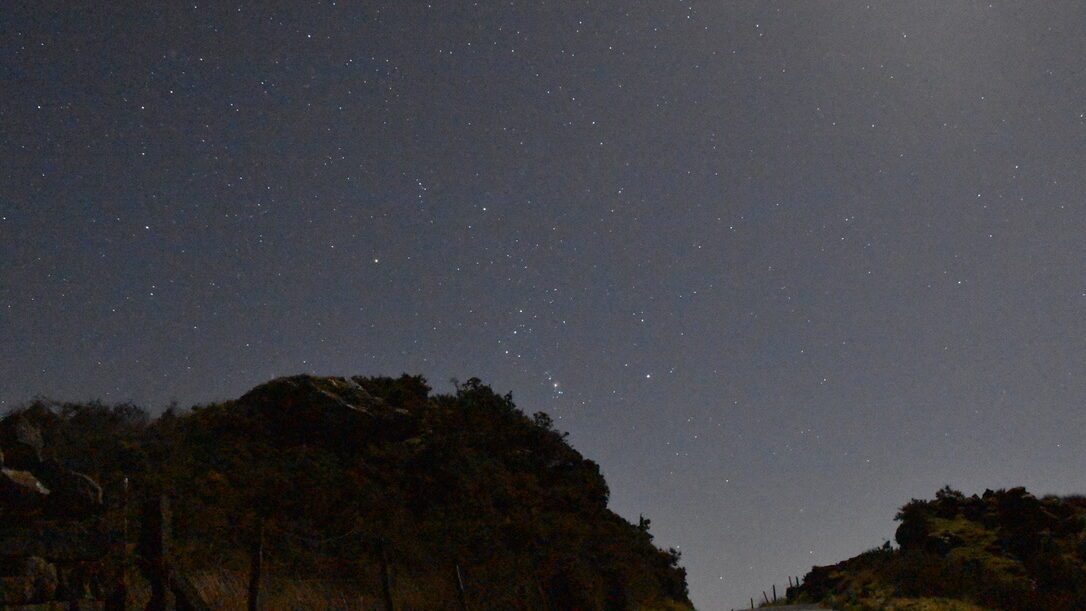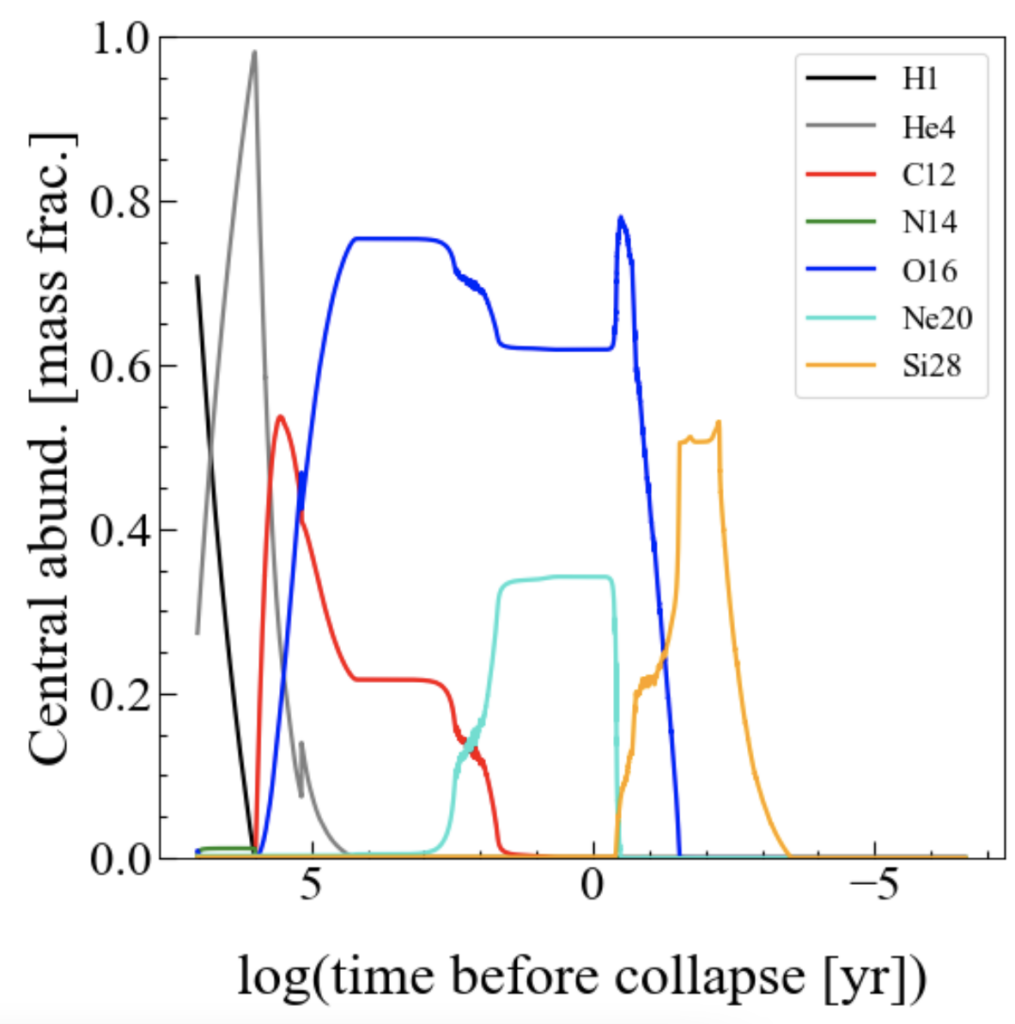Title: The evolutionary stage of Betelgeuse inferred from its pulsation periods
Authors: Hideyuki Saio, Devesh Nandal, Georges Meynet, Sylvia Ekstöm
First author’s institution: Astronomical Institute, Tohoku University, Japan
Status: Submitted to MNRAS

Betelgeuse (commonly pronounced as ‘beetle-juice,’ but sometimes as ‘beh-tel-(g/j)uze’) is the most exciting star in astronomy. It’s clearly recognisable because it’s the second brightest star of one of the easiest constellations to find, Orion. It’s also a red supergiant star, the final stage in a massive main sequence star’s lifetime before it goes supernova. Red supergiants expand significantly during the last stages of their life, a process that cools these stars and gives them their distinctive red hue. Recently, Betelgeuese experienced ‘The Great Dimming’ – a substantial, unexpected decrease in its luminosity, which prompted much speculation about when it may go supernova.
So, when will that happen? The authors of this paper predict that it may go supernova in just a few decades time, making it the first supernova in the Milky Way since 1604 (only a few years before Galileo first demonstrated the telescope!). Below, I’ll explain why they think this.
I myself am strange and unusual
Betelgeuse is an intrinsically variable star, which means its luminosity fluctuates over time. Higher nuclear fusion rates within the star will increase the star’s luminosity, expanding the outer layers of the star outward through radiation pressure and therefore cooling it. The cooling effect will then decrease the nuclear fusion rate, and the luminosity of the star decreases and the outer layers contract again, and so on. Some variability of stars are regular and have different frequencies. Betelgeuse’s variability is observable by the naked eye and has been known for centuries by Aboriginal Australians.
The authors identify four oscillatory modes with periods of 2190 ± 270, 417 ± 24, 230 ± 29, and 185 ± 4 days. They consider the longest period as the fundamental mode, with the shorter periods as overtones. This gives them an estimated radius of the star of 1200 solar radii, which the authors say is supported by some interferometric observations. They simulated models of stellar evolution, beginning at the time when energy production from hydrogen fusion becomes dominant in the star (called the ‘Zero-Age Main Sequence,’ or ZAMS), up until the end of carbon-fusion in the core, and identify the four models that support the observations of Betelgeuse (see Table 1).

Figure 2 compares the simulated radial velocity (RV) of the pulsations, temperature variations, and change in magnitude of a model against observations of Betelgeuse, which the authors conclude to be consistent with each other. Interestingly, this particular model can also predict “The Great Dimming” event (the large dip in the bottom panel), which the authors attribute to constructive interference between the fundamental mode and first overtone pulsations.

It’s Showtime..?
If these models accurately represent Betelgeuse, we can predict when Betelgeuse will go supernova. For example, Figure 3 shows the simulated relative abundances of different elements in the core as a function of time before core collapse. The red curve is the abundance of carbon. Each simulation gives an estimation of the abundance of carbon, and by comparing where these values lie on the curve relative to the x-axis, we get a time of between 1 and 2.5 log-years until supernova – hence a few centuries, if not a few decades until supernova!
But before you get your telescope out and stare incessantly at Betelgeuse for the rest of your life in the hope of catching a beautiful supernova, there are a few caveats… In the end, these are numerical models with many approximations and assumptions which could be inaccurate, and which are calibrated by observations of the surface of the planet. The authors acknowledge that we cannot know at what stage Betelgeuse’s exact evolution is at given surface observations only.
There have also been some questions about the author’s attribution of the 2190 day period as the fundamental frequency. In the literature, it has typically been recognised as a Long Secondary Period, a long variation in a star’s apparent luminosity which is common to many variable stars but of unknown origin. The 417 day period would therefore be Betelgeuse’s fundamental period. This reduces the inferred radius from 1200 solar radii to about 800-900 solar radii, which is better supported by other observations of Betelgeuse.
Additionally, there are other, external explanations for The Great Dimming. Previous Bites (here, here and here) have covered research that explore the idea that the dimming was caused by a Surface Mass Ejection, where the star belches out a vast quantity of gas from its surface. The gas cloud then obscured Betelgeuse from our perspective.

Go Ahead! Make My Millennium!
So maybe Betelgeuse will go supernova in a few decades. Or it won’t. We won’t know until it actually happens.
But researchers will continue to observe the star, and improve their models, and continue to predict when it’ll collapse. Betelgeuse is so prominent in our sky, so close to us (but don’t worry – it’s not so close as to cause problems on Earth as some media suggests!) and so close to supernova, that it’ll continue to be an enigmatic feature in our sky that warrants further study. Personally, I really hope that the models featured in this paper are accurate and I get to see a supernova in my life…
Astrobite edited by Abigail Lee





As an astronomer keenly interested in stellar evolution, it would be very exciting. But I am part of nature too, and no matter how natural that event would be, I don’t think I could escape the feeling that the night sky had a hole in it! Iconic Orion wouldn’t be the same without that shoulder.
I wonder if wishful thinking is coloring the opinions expressed here. Far as I know, the main reason for a star to collapse and then blow up into a supernova is the state of fusion of heavier elements in its core. Once mostly heavier elemnets past carbon are fused, the pressure balance gets out of whack and the star collapses. That will likely happen sometime but to predict a timespan to the Big Blow is rather presumptious.
Most super Nova remnants show many concentric shells of gas and dust that were expelled before the main event. Betelgeuse does not have much of these dust and gas shells yet. These many concentric shells are created before the Super Nova by many outbursts leading up to the main event. However there are some dust clouds in the vicinity of Betelgeuse, but not the organized shells you see in something like the crab nebula, or other super nova remnants. This diming might represent one of the first outbursts. There will have to be many more of these dimming / brightening events before I would think the Main Event is coming real soon. I’m thinking in a thousand years, we might see the main event occur. Don’t hold your breath.
It has very likely already gone supernova, since it is apprx 600 light years from Earth … the light we see is Betelguese as it was 600 years ago!
The thought and feeling have occurred to me as well.
I have been observing both Beetlejuice & Antares for many years. Beetlejuice seems to be more unstable over the last several years. I think it will go supernova soon. However, Antares still looks stable & will go supernova much further in the future.
My son.and I seen one two years ago in the Arkansas skies it was a start that went bright white then appeared to be a line for a second or two and then the brightness dimmed followed by several colors as it expanded and spread out starting from colors from white to yellow to ending in blue and purple and this whole event lasted for I’d say 25-30 minutes and the whole time we’re looking at it we’re both looking at each other and we’re like what is that it wasn’t till after it was over that my son looked at me and said dad what is that the only thing I could think of was a super note so we instantly went inside and looked to see if they could be seen by the naked eye and there has been records of it so to be the only one in our galaxy how would I see one from another galaxy or how it would mean it my son see one from another galaxy if it wasn’t from this especially with just the naked eye